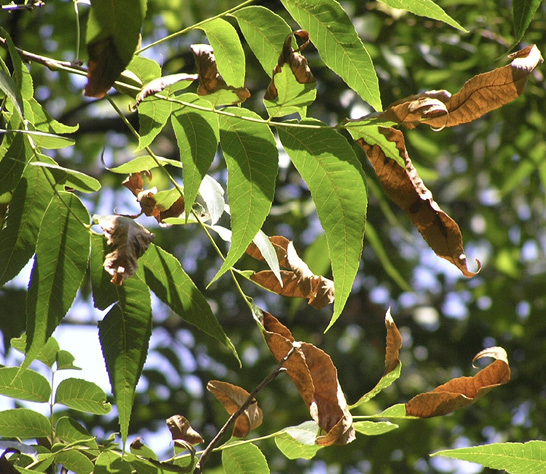Fertilizing Pecan Trees

Pecans are large trees that have significant nutrient requirements. Often, when trees go long periods of time without fertilizer applications, growth becomes poor and leads to reduced nut production. Lack of adequate nutrient availability can also weaken the tree and predispose it to diseases and other disorders; therefore, to ensure tree health and produce consistent and high-quality nuts, it is imperative to fertilize annually.
Soil Testing
A soil test should be the first step in starting a fertilizer regimen. These tests are inexpensive and easy to perform. Contact your local county MSU Extension office for details. A soil test is better when done pre-plant because it will allow for modification of soil pH and addition of nutrients. Table 1 describes desired levels of soil nutrients for a pecan orchard site.
Table 1. Recommended nutrient levels in soils for pecan production.1
|
Element |
Recommended Range2 |
|
Phosphorus |
30–60 |
|
Potassium |
60–150 |
|
Sulfur |
10–50 |
|
Calcium |
400–900 |
|
Magnesium |
90–100 |
|
Boron |
0.5–1.0 |
|
Copper |
0.5–1.5 |
|
Iron |
12–25 |
|
Manganese |
15–40 |
|
Zinc |
15–20 |
|
Soil pH |
6.0–6.5 |
1Table based on Wells (2009). 2pounds per acre.
After planting, a soil test is effective in keeping track of soil pH and monitoring levels of nutrients present in the soil; however, foliar (leaflet) analysis is a better barometer of overall plant nutrient needs. Pecans can grow on a wide range of soil pHs. The recommended range is about 6.5, but, in most cases, soil pH from 6.0 to 7.0 will be sufficient.
Foliar Analysis
Foliar analysis is the most accurate representation of a pecan tree’s nutrient needs. Taking a leaf sample can be done easily in just a few steps:
- Contact your local county Extension office for detailed instructions of how to collect and where to send samples, or see Extension Publication 1224 Plant Analysis Sampling Instructions.
- Collect leaf samples in July.
- Mark trees that were sampled for future reference.
- The sample should be random within a tree and within a cultivar. Collect two leaflets from a few leaves per tree—up to 100 total leaflets.
- Take the leaflets from halfway up the leaf, halfway up the tree, and from all sides of the tree.
- Make sure to sample each cultivar separately.
- If the orchard is not uniform, sample different areas separately.
Establishment Years (1 to 5)
Regardless of whether a newly planted tree is in a commercial orchard or in a homeowner’s yard, weed control is essential for good growth and establishment. Other pests should also be controlled. Likely, first-year trees do not need a fertilizer application, as trees will live off nutrients obtained in the nursery. The tree may grow slowly aboveground in the first year, but the root system will grow abundantly.
Second-year trees should start growing faster, with anywhere from 12 to 36 inches of growth per year. Start applying fertilizer in a band along the dripline, but not next to the trunk. As the tree gets older, apply fertilizer in a band at a distance of 12 inches from the trunk. Fertilizer can also be applied by broadcasting, but this is usually not as efficient as band applications.
Mature Years (6+)
Commercial
Annual fertilizer applications based on leaflet analysis are necessary to maintain a commercial-level pecan orchard (Table 2). The amount of fertilizer needed can vary based on cultivar, management, site, and environment. Improved cultivars generally need more fertilizer than native/seedling pecan trees because they often produce larger nuts and have greater overall yields (Tables 3 and 4). Nitrogen-based fertilizer applications can be applied at one time just before budbreak (March) or as a split application, with half being applied in March and the other half in May.
Table 2. Sufficiency ranges for elements essential to pecan nutrition in both low–input and high–input orchards. These ranges are based on leaflet analysis when leaves are fully expanded.1
|
Element |
Low Input |
High Input |
|
Nitrogen (N) |
2.3–3.0 % |
2.4–3.0 % |
|
Phosphorus (P) |
0.12–0.30 % |
0.14–0.30 % |
|
Potassium (K) |
0.85–2.50 % |
1.00–2.50 % |
|
Sulfur (S) |
0.20–0.35 % |
0.20–0.35 % |
|
Calcium (Ca) |
0.70–1.75 % |
0.70–1.75 % |
|
Magnesium (Mg) |
0.30–0.60 % |
0.30–0.60 % |
|
Boron (B) |
15–50 ppm2 |
15–50 ppm |
|
Copper (Cu) |
6–30 ppm |
6–30 ppm |
|
Iron (Fe) |
50–300 ppm |
50–300 ppm |
|
Manganese (Mn) |
100–2000 ppm |
100–2000 ppm |
|
Zinc (Zn) |
60–150 ppm |
60–150 ppm |
|
Nickel (Ni) |
>2.5 ppm |
>2.5 ppm |
1Table based on Smith et al. (2012). 2ppm=parts per million (equal to milligrams per gram).
Homeowner
If the lawn surrounding the pecan tree is being fertilized, this could add some nutrition to the tree; however, it may not be enough to satisfy the nutritional needs of the tree because most of the fertilizer will be used by the grass. One-half pound of ammonium nitrate (or similar) per 100 square feet can be applied under the dripline of the tree. This should be done around the starting time of budbreak (March/April) and again in late spring or early summer (May/June). Roughly 6 to 12 inches of new growth is desired every year.
Nutritional Elements
Macronutrients and Micronutrients
Proper and balanced fertilization is important because pecan yields are proportional to the amount of the most limiting nutrient. This means if only one nutrient is below normal and all others are sufficient, yields can still suffer. Nutrients that a pecan tree requires are in two categories: macronutrients and micronutrients. Macronutrients are needed in larger amounts by pecan trees. Those elements are nitrogen (N), phosphorus (P), potassium (K), sulfur (S), calcium (Ca), and magnesium (Mg). Essential plant functions performed by macronutrients include the
production of proteins, nucleic acids, and chlorophyll; the activation of enzymes; photosynthesis; and sugar transport.
Micronutrients are essential for plant growth and development but are needed in minute amounts. They include boron (B), chloride (Cl), copper (Cu), iron (Fe), nickel (Ni), manganese (Mn), molybdenum (Mo), and zinc (Zn). Although the plant needs only small amounts of these nutrients, they play critical roles in many plant functions such as translocation of sugar and carbohydrates, cell wall formation, carbohydrate and protein metabolism, chlorophyll development, electron transport, and many others.
Interactions can occur among these elements. For instance, when P is at very high levels, both Zn and Cu may become unavailable or less available to the tree. As a result, it is very important to keep each element within the recommended sufficiency range and also optimize soil pH and provide sufficient water to the tree.
Nitrogen
The single-most required nutrient is nitrogen. Pecan trees grow quickly and need a good amount of nitrogen for production. High-input, improved cultivars may require more than 250 pounds of actual nitrogen per acre per year for best production. Low-input orchards (those without irrigation and few spray applications) and native pecan trees do not require as much nitrogen and can perform with around 150 pounds of actual nitrogen per acre per year. See Table 3 for details on recommendations based on foliar analysis.
Zinc
Pecan trees are heavy users of zinc. It is an essential nutrient for good growth and nut production. Zinc is commonly applied to improved cultivar pecan trees as a foliar spray. This ensures quick uptake by the tree. Young trees and fast-growing trees need applications of zinc on new growth during the spring starting at budbreak and continuing for three sprays at 2- to 3-week intervals. Zinc sulfate is the primary source of zinc and can be mixed at 2 to 3 pounds per 100 gallons of water.
Soil applications of zinc are less effective than foliar applications and are only useful when the soil pH is below 6.0. If soil pH is below 6.0, then one-half pound of zinc sulfate per year of age of the tree can be soil-applied under the tree up to 10 pounds per tree total. Even so, foliar applications are the highly preferred method. See Table 4 for more information.
Table 3. Recommendations for managing nitrogen (N) in low-input and high-input pecan orchards.1
|
Low-Input |
High-Input |
||||
|
Range |
Concentration |
Recommendation |
Range |
Concentration |
Recommendation |
|
Low |
<2.3% |
Double last year’s application or add 150 lb/acre N. |
Very Low |
>2.3% |
Double last year’s application or add 150 lb/acre N. |
|
Normal |
2.3–2.5% |
Continue with present application rates. |
Low |
2.3–2.4% |
Increase N by 30% or 125 lb/acre N. |
|
Normal |
2.5–2.7% |
Decrease N by 20%. |
Normal |
2.4–2.7% |
Continue with present application rates. |
|
Normal |
2.7–3.0% |
Decrease N by 50%. |
Normal |
2.7–3.0% |
Decrease N by 30%. |
|
Above Normal |
>3.0% |
Do not add N. |
Above Normal |
>3.0% |
Decrease N by 50%. |
1Table based on Smith et al. (2012)
Table 4. Recommendations for managing macro- and micronutrients in low-input and high-input pecan orchards based on leaf analysis results.1
|
Low-Input |
High-Input |
||||
|
Nutrient |
Range |
Concentration |
Recommendation |
Concentration |
Recommendation |
|
Phosphorus (P) |
Low |
<0.12% |
Apply 100 lb/acre phosphate. |
<0.14% |
Apply 100 lb/acre phosphate. |
|
Normal |
>0.14% |
None needed. |
>0.14% |
None needed. |
|
|
Potassium (K) |
Low |
<0.85% |
Apply 100 lb/acre potassium oxide. |
<1.0% |
Apply 100 lb/acre potassium oxide. |
|
Normal |
>0.85% |
None needed. |
>1.0% |
None needed. |
|
|
Sulfur (S) |
Low |
<0.20% |
Use ammonium sulfate as nitrogen source and/or zinc sulfate as foliar spray. |
<0.20% |
Use ammonium sulfate as nitrogen source and/or zinc sulfate as foliar spray. |
|
Normal |
>0.20% |
None needed. |
>0.20% |
None needed. |
|
|
Calcium (Ca) |
Low |
<0.70% |
Apply lime to increase soil pH to 6.8. |
<0.70% |
Apply lime to increase soil pH to 6.8. |
|
Normal |
>0.70% |
None needed. |
>0.70% |
None needed. |
|
|
Magnesium (Mg) |
Low |
<0.30% |
Test soil pH and use lime if needed to raise pH or use magnesium sulfate. |
<0.30% |
Test soil pH and use lime if needed to raise pH or use magnesium sulfate. |
|
Normal |
>0.30% |
None needed. |
>0.30% |
None needed. |
|
|
Boron (B) |
Low |
<15 ppm2 |
Apply soluble boron at 0.5–1 lb/acre as first leaf unfurls, then twice at 2-week intervals. |
<15 ppm |
Apply soluble boron at 0.5–1 lb/acre as first leaf unfurls, then twice at 2-week intervals. |
|
Normal |
>15 ppm |
None needed. |
>15 ppm |
None needed. |
|
|
Above Normal |
>300 ppm |
Check water source for high B. |
>300 ppm |
Check water source for high B. |
|
|
Manganese (Mn) |
Low |
<100 ppm |
Apply manganese sulfate at 6 lb/acre beginning as first leaf unfurls, then twice later in season. |
<100 ppm |
Apply manganese sulfate at 6 lb/acre beginning as first leaf unfurls, then twice later in season. |
|
Normal |
>100 ppm |
None needed. |
>100 ppm |
None needed. |
|
|
Zinc (Zn) |
Low |
<60 ppm |
Apply 3–6 lb/acre of zinc sulfate on bearing trees, 1–2 lb/100 gal water on nonbearing trees. Apply at least 3 times during spring and summer. Soil applications may be used in acidic soils. |
<60 ppm |
Apply 3–6 lb/acre of zinc sulfate on bearing trees, 1–2 lb/100 gal water on nonbearing trees. Apply at least 3 times during spring and summer. Soil applications may be used in acidic soils. |
|
Normal |
>60 ppm |
Continue Zn spray program as is. |
>60 ppm |
Continue Zn spray program as is. |
|
|
Iron (Fe) |
Low |
<50 ppm |
Usually induced by environmental conditions and will resolve itself when conditions improve. If not, use iron chelate. |
<50 ppm |
Usually induced by environmental conditions and will resolve itself when conditions improve. If not, use iron chelate. |
|
Normal |
>50 ppm |
None needed. |
>50 ppm |
None needed. |
|
|
Copper (Cu) |
Low |
<6 ppm |
Apply copper sulfate or copper chelate. |
<6 ppm |
Apply copper sulfate or copper chelate. |
|
Normal |
6 to 20 ppm |
None needed. |
6 to 20 ppm |
None needed. |
|
|
Above Normal |
>20 ppm |
Determine source of Cu and adjust. |
>20 ppm |
Determine source of Cu and adjust. |
|
|
Nickel (Ni) |
Low |
<2.5 ppm |
Apply Ni as a foliar application. |
<2.5 ppm |
Apply Ni as a foliar application. |
|
Normal |
>2.5 ppm |
None needed. |
>2.5 ppm |
None needed. |
|
1Table based on Smith et al. (2012). 2ppm=parts per million (equal to milligrams per gram).
Others
Phosphorus and potassium are also required for pecan production. Any deficit with these nutrients should be rectified before planting. If done pre-plant, subsequent applications will likely be infrequent. Nutrient deficiencies from Mn, Ni, B, and others are rarely observed to cause problems in pecan trees; however, they can occur. See Table 4 for recommendations regarding these nutrients.
Abnormalities in a plant’s appearance, development, function, or growth may be caused by various factors.
These abnormalities are often visualized as symptoms. Abnormalities may be classified as diseases or disorders depending on the nature of the causal agent. Diseases are caused by biotic (living) organisms such as bacteria, fungi, nematodes, and viruses. These disease-causing organisms are called plant pathogens. Pathogens that cause disease can be spread from plant to plant under favorable conditions. Disorders are caused by abiotic (nonliving) factors such as nutritional deficiencies, herbicides, and environmental conditions (e.g., drought,
freezing temperatures). Unlike diseases, disorders are not infectious.
When plants are not performing as expected, it is important to correctly identify the cause of the problem so that appropriate management actions may be taken. Unfortunately, abiotic and biotic factors can produce similar symptoms, which can make it difficult to quickly discern the cause of a problem (Figure 1). These are some examples of nutritional disorders and diseases in pecan trees that can cause confusion:
- Mouse-ear (nutritional disorder). Symptom: leaflets with rounded, blunt ends. Mouse-ear is caused by a nickel deficiency.
- Nitrogen scorch (nutritional disorder) and pecan bacterial leaf scorch (disease). Common symptom: leaflets appear “scorched,” and portions of the leaflet are brown and necrotic (dead). Nitrogen scorch is caused by an excess of nitrogen combined with a shortage of potassium. Pecan bacterial leaf scorch is caused by a bacterium that lives in the water-conducting tissues (xylem) of the tree and is graft- and insect-transmitted.
- Zinc deficiency (nutritional disorder) and bunch disease (disease). Common symptom: “bunching” (shortening of internodes). Bunch disease is caused by a type of plant pathogen called a phytoplasma that is graft-transmitted. The method of natural spread of this pathogen is unknown.
As a final reminder, applying fertilizer to pecan trees is not a cure-all. Other factors such as site, soil moisture, and pest management are as important as, if not more important than, fertilizer applications for production of a successful crop. These recommendations are to be used as guidelines for application. Each site is different and may require modification from these guidelines based on owner/operator observation and experience.
References
Garcia, M.E. and D. Chapman. 2007. Fertilizer and cultural recommendations for pecan trees. University of Arkansas Cooperative Extension Service. FSA6131.
Smith, M.W., C.T. Rohla, and W.D. Goff. 2012. Pecan leaf elemental sufficiency ranges and fertilizer recommendations. HortTechnology 22:594-599.
Wells, M.L. 2009. Pecan nutrient element status and orchard soil fertility in the Southeastern Coastal Plain of the United States. HortTechnology 19:432-438.
Online Resources
Plant Disease and Nematode Diagnostic Services
Soil Testing For the Homeowner
Plant Analysis Sampling Instructions
Publication 3055 (POD-04-23)
By Eric T. Stafne, PhD, Extension and Research Professor, Coastal Research and Extension Center; Rebecca A. Melanson, PhD, Assistant Extension Professor, Central Mississippi Research and Extension Center; and Jeff Wilson, PhD, Assistant Professor, North Mississippi Research and Extension Center.
The Mississippi State University Extension Service is working to ensure all web content is accessible to all users. If you need assistance accessing any of our content, please email the webteam or call 662-325-2262.




